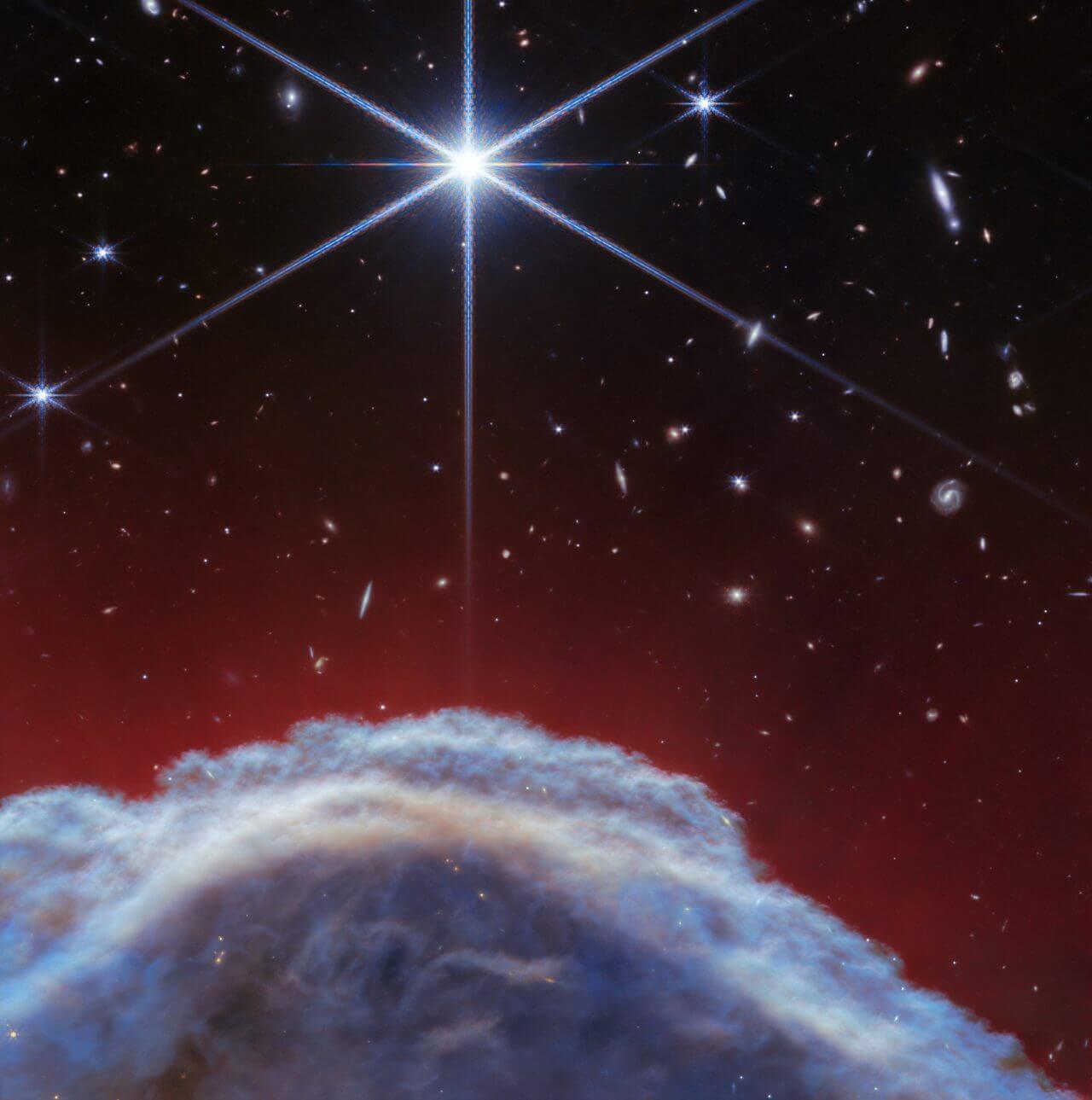This is a close-up of the famous dark nebula “Horsehead Nebula” located about 1,300 light-years away in the direction of the constellation Orion. The white smoke-like material at the bottom of the image is “horse's mane”, and the structure of the molecular cloud containing various materials such as hydrogen, methane and ice (water ice) is captured in detail.

A dark nebula is a celestial body with a high density of gas and dust. It is called a “dark” nebula because the dust blocks visible light emanating from celestial bodies on the other side, making the area appear dark from Earth.
In the direction of the Orion constellation, there is a vast star-forming region called the Orion Molecular Cloud, of which the Horsehead Nebula is a part. In visible light, the background of the Horsehead Nebula appears red. This red light is emitted from hydrogen ionized by ultraviolet radiation emitted by massive stars. This region is called the hydrogen ionized region or HII region. Incidentally, the region of ionized hydrogen dotting the background of the Horsehead Nebula is known as the emission line nebula IC 434.
This image was created based on data acquired by the James Webb Space Telescope (JWST) Near-Infrared Camera (NIRCam). Because the Webb Space Telescope primarily observes infrared wavelengths that cannot be seen by the human eye, the colors of published images are colored according to the filters used during acquisition.
![[▲ صور مقارنة لسديم رأس الحصان رصدها تلسكوب إقليدس الفضائي (يسار)، وتلسكوب هابل الفضائي (وسط)، وتلسكوب جيمس ويب الفضائي (يمين) (مصدر الصورة: ESA/Euclid/Euclid Consortium/NASA، معالجة الصور بواسطة J.- C. Cuillandre (CEA Paris-Saclay)، G. Anselmi، NASA، ESA، وفريق تراث هابل (AURA/STScI)، ESA/Webb، CSA، K. Misselt (جامعة أريزونا) وA. Abergel (IAS/ جامعة باريس ساكلاي، المركز الوطني للبحوث العلمية)، م. زماني (وكالة الفضاء الأوروبية/ويب)]](https://sorae.info/wp-content/uploads/2024/04/Horsehead-Nebula-James-Webb-JWST-NASA-ESA-STScI-weic2411c.jpg)
![[▲ صور مقارنة لسديم رأس الحصان رصدها تلسكوب إقليدس الفضائي (يسار)، وتلسكوب هابل الفضائي (وسط)، وتلسكوب جيمس ويب الفضائي (يمين) (مصدر الصورة: ESA/Euclid/Euclid Consortium/NASA، معالجة الصور بواسطة J.- C. Cuillandre (CEA Paris-Saclay)، G. Anselmi، NASA، ESA، وفريق تراث هابل (AURA/STScI)، ESA/Webb، CSA، K. Misselt (جامعة أريزونا) وA. Abergel (IAS/ جامعة باريس ساكلاي، المركز الوطني للبحوث العلمية)، م. زماني (وكالة الفضاء الأوروبية/ويب)]](https://sorae.info/wp-content/uploads/2024/04/Horsehead-Nebula-James-Webb-JWST-NASA-ESA-STScI-weic2411c.jpg)
The following image compares the Horsehead Nebula captured by three space telescopes. The image on the left was taken by the European Space Agency's (ESA) Euclid Space Telescope, the center image was taken by the Hubble Space Telescope (HST), and the image on the right was taken by the Webb Space Telescope's NIRCam, and is the same as at the beginning. This is the photo that was taken. As you move from left to right, the Horsehead Nebula is arranged in close-up phases.
Related articles
・ The “Horsehead Nebula” in the Orion constellation imaged by the European Space Agency's Euclid Space Telescope (November 17, 2023)
・Hubble's 23rd Anniversary, New Color of the Horsehead Nebula (April 20, 2013)
According to the US Space Telescope Science Institute (STScI), which operates the Webb Space Telescope, the Horsehead Nebula is well known as the photodissociation region (PDR). The photodissociation region lies on the border between the ionized hydrogen region and the molecular cloud, a region of electrically neutral gas and dust formed by the action of ultraviolet radiation emitted by young, massive stars. Light from photodetachment regions provides a unique tool for studying the physical and chemical processes that drive the evolution of the interstellar medium throughout the universe, from the early universe to the present.


On the other hand, this image was created based on data obtained by the Webb Space Telescope's Mid-Infrared Observatory (MIRI). This close-up image of a narrower area than the initially published NIRCam image captures infrared radiation emitted by dust-like silicates and soot-like polycyclic aromatic hydrocarbons.
Based on observational data of the Horsehead Nebula with the Webb Space Telescope, a research team led by Alain Abergel from the French Institute of Space and Astrophysics (IAS) was able to determine the structure of the bright edge of the Horsehead Nebula 40 to 40 years ago. For the first time on a small scale of 400 astronomical units. The Webb Space Telescope discovered properties that allow us to track the movement of dust drifting with hot gas from molecular clouds that have been evaporated by ultraviolet radiation, and how the dust blocks light and emits infrared radiation. Through their investigations, they were able to obtain a deeper understanding of the shape of the nebula in multiple dimensions. In order to gain knowledge about the evolution of the physical and chemical properties of matter throughout the nebula, the research team will use data from spectroscopic observations (an observational method that obtains spectra that indicate the brightness of each wavelength of electromagnetic waves) using a Webb device. The space telescope is analyzing the results.
Images of the Horsehead Nebula observed by the Webb Space Telescope were released by STScI, the National Aeronautics and Space Administration (NASA) and the European Space Agency on April 29, 2024. Additionally, a paper summarizing Abergel et al's findings was published in the journal Astronomy & Astrophysics.
source
- STScI Webb captures the top of the famous Horsehead Nebula in unprecedented detail
- NASA Webb captures the top of the famous Horsehead Nebula in unprecedented detail
- ESA/Web – Webb captures the famous Horsehead Nebula in unprecedented detail
- Abergel et al. – JWST observations of the horsehead photon-dominated region I. First results from near- and mid-infrared multiband imaging (Astronomy and Astrophysics)
Editorial/Editing/Suray Department

“Travel maven. Beer expert. Subtly charming alcohol fan. Internet junkie. Avid bacon scholar.”






More Stories
The ranking of the best survival horror games selected by the IGN US editorial team has been released! Resident Evil RE:2 ranked first
Enjoy a hot cigarette while looking at whales and tropical fish under the sea ⁉︎ “Ploom Dive” is an amazing spatial video experience using Apple Vision Pro
Apple Watch now supports sleep apnea, watchOS 11 released – Impress Watch